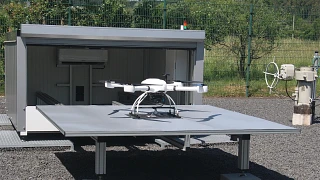Change Language :

Drone in a box
Lightweight, maintenance-free components for drone garages
Most drone flights are controlled manually ("hands-on piloting"). Take-off is initiated, flown and landed using a smartphone and/or remote control. The pilot stands in close proximity to the drone in order to have it in their field of vision. After around 20 to 30 minutes, the battery capacity is exhausted and the user must charge the drone via a charging cable at a power socket. This procedure is impractical, uneconomical and impracticable for many industrial applications.
In January 2021, the US Federal Aviation Administration (FAA) authorised the first fully autonomous commercial drone flights. A company based in Massachusetts was granted permission to operate drones without a hands-on control system or direct observation by a pilot. While operations are only permitted in rural areas and at altitudes below 122 metres (400 feet), the approval is a significant step in expanding the commercial applications of drones for farmers, postal operators, power plant operators and other customers.
motion plastics for the drone box

Areas of application
There are numerous areas of application for the Drone in a Box, here are a few examples:
- In the security industry, the concept is used to automatically take off in the event of an alarm, fly to the location of the alarm and provide close-up images of the crime scene. Planned regular patrol flights are also conceivable. In addition, companies have already used the technology to support security at major events.
- In agriculture, the concept is already being used successfully for inspection and surveying tasks. With special cameras on the drone, changes in vegetation can be recognised at an early stage.
- In the maintenance of factories or power plants, drones in a box are used to stream aerial images and factory data to staff in real time. This can help to detect gas/water leaks, for example, or identify necessary maintenance.
- Packing stations have already established themselves in many parts of the world as a practical option for time-independent parcel delivery. If these stations are expanded to include take-off and landing sites for drones, numerous parcel deliveries can be automated in the future.

Maintenance-free linear bearing technology in drone hangars
The company exabotix offers drones that automatically take off for inspection flights to inspect gas pipelines. The provider has also designed its own drone hangars so that they can take off and land again in the most remote locations. The central component of these hangars - a platform that can be extended by 4.5 metres with the drone on it - moves completely lubrication- and maintenance-free thanks to drylin® W guide rails.
Consulting
I look forward to answering your questions

Lars Braun+49 2203 9649 218Write e-mail
Shipping and consultation
In person:
Monday to Friday from 7 am - 8 pm.
Saturdays from 8 am- 12 pm.
Online:
24h
WhatsApp-Service:
Montag – Freitag: 8 – 16 Uhr







